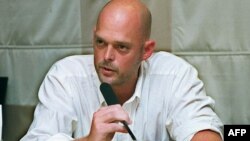Colleagues of the late Nate Thayer paid tribute to a “fearless” American journalist who went “further than all of us” in his search for answers about Khmer Rouge atrocities in Cambodia.
“He was fearless in terms of his work style, and he was uncompromising when it comes to pursuing the truth,” said Ker Munthit, who worked with Thayer at The Phnom Penh Post in the 1990s.
“On a regular basis, he scooped the world with his stories on Cambodian political conflicts,” Munthit told VOA shortly after Thayer’s death in early January at 62.
Thayer arrived in Southeast Asia in the late 1980s and worked as a stringer for The Associated Press. Over the next decade, he established himself with his coverage of the end of the Khmer Rouge regime and the emergence of “modern” Cambodia.
No series of scoops was bigger than Thayer’s reporting on the trial of Cambodian dictator Pol Pot in 1997 and his interview with the former leader a few months later. But he also broke stories on renegade combatants, heroin trafficking networks linked to Cambodia’s elite, and factional fighting that saw tanks return to the streets of Phnom Penh after a few years of relative peace.
Thayer was a sharp writer — filing lengthy dispatches for publications including the Far Eastern Economic Review. But his sources were what truly set him apart.
“He went further than all of us,” Kevin Barrington, an Irish journalist who worked with Thayer at The Phnom Penh Post, told VOA in a phone call. “He’d go off on serious treks deep into Cambodia with guerillas. He had an appetite for risk.”
Thayer nearly died during one of those trips. In October 1989, the vehicle he was in drove over two mines. The driver was killed, and Thayer suffered shrapnel wounds.
But he survived and kept covering the conflict, driven by a mission to track down the man who led the Khmer Rouge as it murdered and starved to death some 3 million Cambodians during its four-year reign in the 1970s.
“Although he did many things in Cambodia, he never deviated from that mission that he had to find Pol Pot. And that was a complete obsession,” Nayan Chanda, former editor of the Far Eastern Economic Review, told VOA.
The breakthrough came in 1997 when Brother No. 1, as Pol Pot was called, was arrested by rival Khmer Rouge commander Ta Mok. Thayer, along with television cameraman David McKaige, was invited to document the show trial that followed.
The trial was the first time the notorious war criminal had been seen by the Western world in decades. Thayer’s footage was broadcast on ABC News’ “Nightline” — beginning a yearslong legal dispute over rights.
A few months later, Pol Pot, who could barely walk without help, reached out through intermediaries to arrange an interview, Chanda recalled.
Thayer wrote for the Review that Pol Pot was “chillingly unrepentant,” willing to admit to “mistakes” made by the regime but blaming mass killings on others and arguing that were it not for his revolution, Cambodia would have become part of Vietnam.
That was the dictator’s last interview before his death the next year — which Thayer also scooped.
McKaige often teamed with Thayer on reporting trips into western Cambodia and along the Thai border, where democratic resistance forces — aligned with Khmer Rouge remnants against Hun Sen’s Hanoi-backed government — based their operations.
Now living in Singapore, McKaige told VOA that Thayer was a rare foreigner who didn’t bring a political agenda to his work in Cambodia during a time when the country was a flashpoint for geopolitical tensions.
“I think he provided some balance to an otherwise extremely left-liberal view of what happened in Cambodia,” McKaige said. “Both choices were bad.”
And some of the hardest fighters in Cambodia’s decades of war opened up to Thayer.
“He’s an incredibly open and authentic person, and that openness is reciprocated when he talks to people,” McKaige said.
Barrington, who later worked for Agence France-Presse in Phnom Penh, told VOA that Thayer’s relationships with his Khmer Rouge sources made some of his colleagues uncomfortable. At times, other reporters felt he was too soft on senior leaders when he scored rare interviews with them, such as former head of state Khieu Samphan.
“But I think this was all part of his uber plan to try and get to Pol Pot,” Barrington said. “When he did get to Pol Pot, he didn't back away from asking him tough questions.”
Thayer worked hard and played hard, friends said. He often shared an anecdote about charging The Associated Press nearly $500 for gin and tonics, arguing it was a medical expense given the antimalarial quinine in the tonic.
But drinking would become a demon.
“Anybody who did the stuff we did and continues to do it in the spirit of trying to bring horrible things to the world's attention [is] always going to be a little rough around the edges,” McKaige said.
Thayer would go on to report from around the world, including Iraq, the former Yugoslavia, Cuba and North Korea. More recently, he returned to living in the United States.
Munthit recalled visiting him at his U.S. farmhouse in the early 2000s. He said Thayer slept until early evening, woke up to feed the ducks in a nearby pond, and spent the night working on his unfinished memoir, “Sympathy for the Devil.”
Un Sokhom, a former publisher of an opposition newspaper in Cambodia, said the country had lost a rare living witness to the man who oversaw the massacre of so many.
"We are very sad that the ideas and further publication that he wrote and prepared for release have not been released. It will be buried," he said.
Barrington said Thayer’s friends are discussing how they can finish the book that he never completed.
This story originated in VOA’s Khmer Service. Sok Khemara contributed.





